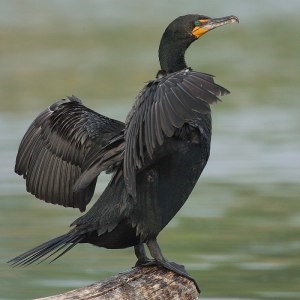The province is jumping the gun with a proposal to allow for the hunting of cormorants, according to a local naturalist.
Bob Bowles is concerned about the Ministry of Natural Resources and Forestry’s (MNRF) plan to declare open season on the double-crested cormorant.
“Nature has a balance and we, as humans, tend to upset that balance,” he said. “Sometimes we need human intervention, but it should be a last resort.”
The problem with cormorants isn’t at that point yet, Bowles said.
The MNRF’s proposal would see the cormorants — currently protected under the Migratory Birds Convention Act — reclassified as “game birds.” Hunters would be able to kill 50 per day, with no possession limit.
“There continues to be concerns expressed by some groups (commercial fishing industry, property owners) and individuals that cormorants have been detrimental to fish populations, island forest habitats, other species and aesthetics,” the ministry wrote in its proposal. “To respond to these concerns, the ministry is proposing to create a hunting season for double-crested cormorants in Ontario. This new population management tool would allow persons who hold a small game licence to hunt these birds.”
Bowles feels the MNRF is getting ahead of itself.
“DDT knocked (the cormorants) out in the ’70s and, since 2000, their population has exploded due to all the invasive fish,” he said.
But even the ministry acknowledges “populations have since stabilized or declined slightly.”
“Nature can stabilize nicely,” Bowles said, noting removing the protection for cormorants could “devastate” the population.
He said there are two cormorant colonies in the Orillia area — Ship Island on Lake Couchiching as well as an area between the former Huronia Regional Centre and the city’s landfill.
Cormorants aren’t the most popular birds. The smell emanating from Ship Island can be intolerable. Also, as noted by the Ontario Federation of Anglers and Hunters, “Where cormorant numbers are high, they can negatively affect terrestrial habitats by chemical and physical means through corrosive acidic guano, and stripping/breaking tree branches.”
That is true, Bowles said, but he doesn’t believe the problem is as bad as some make it out to be.
“These areas are very contained. You get a big colony in one area,” he said. “Yes, they are depleting habitat, but it’s very localized around their colony.”
He’s more worried about water pollution from birds that are shot and not retrieved.
Bowles also isn’t buying the argument about the cormorants’ impact on fish populations.
“They don’t really go after game fish,” he said.
Cormorants also play an important role that shouldn’t be overlooked, Bowles added, noting they feed on the invasive round goby, which has “devastated fish populations by eating the eggs and the young.”
To read the ministry’s proposal and provide feedback, click here.
